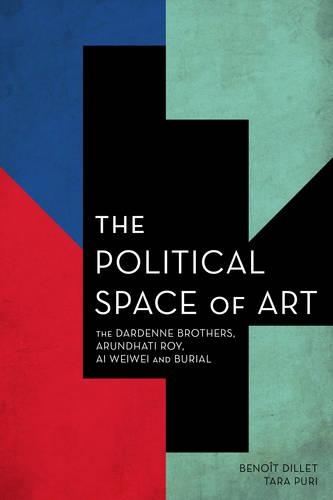
The Political Space of Art: The Dardenne Brothers, Arundhati Roy, Ai Weiwei and Burial
(Paperback)
Available Formats
Publishing Details
The Political Space of Art: The Dardenne Brothers, Arundhati Roy, Ai Weiwei and Burial
By (Author) Benot Dillet
By (author) Tara Puri
Bloomsbury Publishing PLC
Rowman & Littlefield International
18th May 2016
United Kingdom
Classifications
Tertiary Education
Non Fiction
Political science and theory
Philosophy: aesthetics
Social and political philosophy
700.4581
Physical Properties
Paperback
138
Width 152mm, Height 227mm, Spine 11mm
218g
Description
This book studies the tension between arts and politics in four contemporary artists from different countries, working with different media. The film directors Luc and Jean-Pierre Dardenne film parts of their natal city to refer to specific political problems in interpersonal relations. The novelist Arundhati Roy uses her poetic language to make room for peoples desires; her fiction is utterly political and her political essays make place for the role of narratives and poetic language. Ai Weiwei uses references to Chinese history to give consistency to its economic miracle. Finally, Burials electronic music is firmly rooted in a living, breathing London; built to create a sound that is entirely new, and yet hauntingly familiar. These artists create in their own way a space for politics in their works and their oeuvre but their singularity comes together as a desire to reconstruct the political space within art from its ruins. These ruins were brought by the disenchantment of 1970s: the end of art, postmodernism, and the rise of design, marketing and communication. Each artwork bears the mark of the resistance against the depoliticisation of society and the arts, at once rejecting cynicism and idealism, referring to themes and political concepts that are larger than their own domain. This book focuses on these productive tensions.
Reviews
This is a novel and original work of political theory by two exciting and emerging scholars in the field. -- Robert Porter, Director of the Centre for Media Research, Ulster University
Using four artists working in different art forms filmmakers The Dardenne Brothers, writer Arundhati Roy, visual artist Ai Weiwei and musician Burial the book explores the formation of creative work within a thick web of political relationships and spheres Unlike most books about art, usually written from an art or art historical perspective, this publication is written from a political/philosophical standpoint. Dillet and Puri analogise in the introduction that, just as Deleuze and Guattari argue for a non-philosophical approach to philosophy to see the different facets of how it really operates, a non-art approach to art is required to open up insights into its effect. * International Sculpture Center *
Overall, this book offers a stimulating examination of the relationship between art and politics through the theoretical lens of the philosophy of art in an innovative way. The authors provide a rich set of references to different authors such as Blanchot, Deleuze, Stiegler, among others. [] [T]he value of this book is not limited to its selection of artists, but also to its focus on the political space of art and materiality. This gets rid of the traditional distinction between art, politics and the world, bringing forth a more powerful critique of our time by moving beyond the analysis of meaning or artistic merit into how art works. Although the analysis of the materiality of art fits remarkably well with the artworks examined, it might also be useful for the study of other artists, not as a method, but as a reminder of the physical space of art and its connections to the world. * Marx and Philosophy Review of Books, 9 July 2018 *
Author Bio
Benot Dillet is an Assistant Lecturer in Political Thought at the School of Politics and International Relations, University of Kent. Tara Puri is a Global Research Fellow at the Institute of Advanced Study, University of Warwick.
